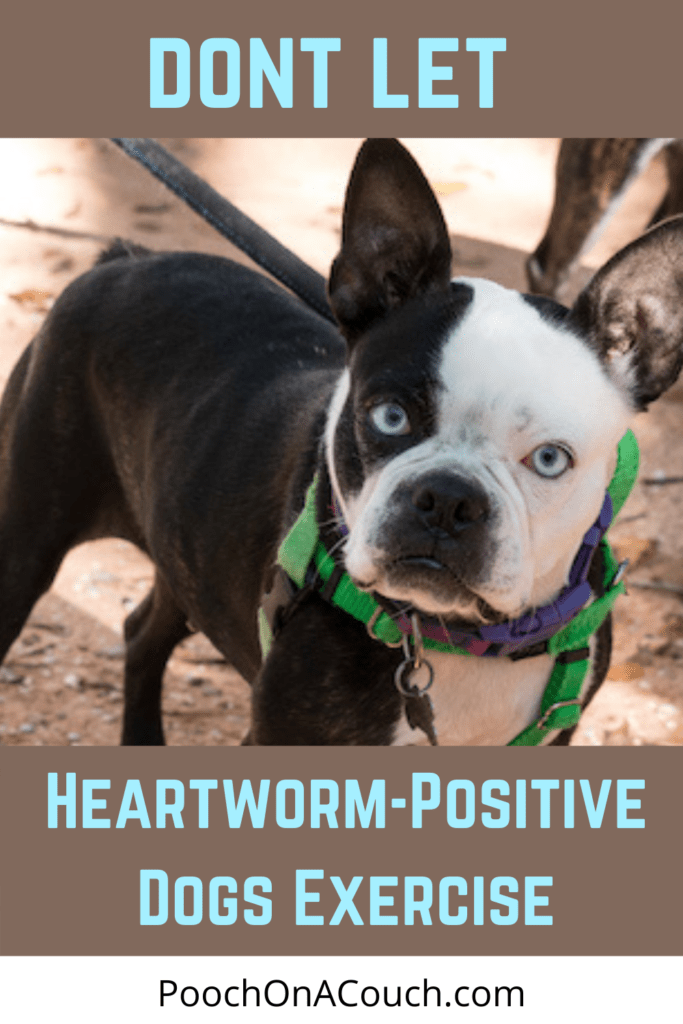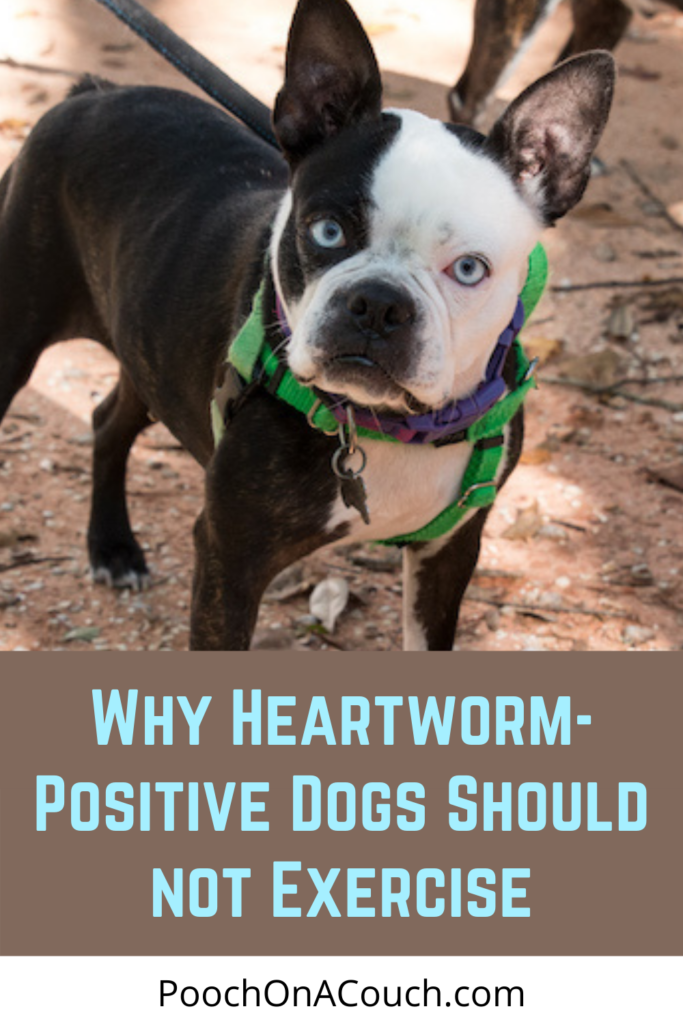Heartworm positive dogs should not exercise. From the day they are diagnosed and receive their first dose of heartworm preventive until the heartworm treatment is complete, the American Heartworm Society recommends that you restrict a dog’s activity.
Disclaimer: I am not a veterinarian. I write this post based on my experiences and my understanding of the literature. Your veterinarian should guide you on exercise requirements for YOUR DOG based on their clinical assessment. I hope you find this post useful.
Watching a Heartworm Positive Dog Exercise Makes Me Nervous
A classmate of mine recently adopted a beautiful, young dog from a southern shelter. The dog tested positive for heartworm; she wanted the dog regardless and stated her plans to provide the dog heartworm treatment.
Fast forward two weeks, and I see a social media video of this dog having a grand time in his new home, and my heart sank.
He was playing an exciting game of fetch and retrieve. IN THE LAKE.
Knowing the risks associated when a heartworm-positive dog exercises, I’ll worry about him. Scientists have long known that heartworm-positive dogs should not exercise.
Heartworm Positive Dogs Should Not Exercise Even On The Slow Kill Protocols.
According to the American Heartworm Society, I=if you are doing a fast-kill protocol, your heartworm-positive dog should not exercise for a minimum of 4 months, and the recommendations seem to be shifting to even 6 months – from diagnosis to 8 weeks after treatment is completed.
Likewise, if you are doing a slow-kill protocol, this means your dog should not run and play for up to two-and-a-half years, or longer. (Slow-kill is slow; many dogs do not test negative for 24 months, some dogs go three years on a slow-kill treatment.) That’s a long time to tell your dog they can’t chase a tennis ball or follow a lizard, or go on a long walk.
Defining Exercise Restriction for Heartworm Positive Dogs
Are you saying that my heartworm positive dog has to live in a cage?
No.
Let’s talk about exercise and what it means for heartworm positive dogs.
Your veterinarian is going to advise you that your heartworm positive dog should not do activities that keep the dog’s heart rate elevated. This means your heartworm positive dog should not run, jump, sprint, go for long walks, play chase, fetch, have zoomies, run up and down the stairs, and the like.
Can your dog jump on the couch after heartworm treatment? Maybe. Clear that activity with your veterinarian as only they know your dog’s overall health. Usually, when I take dogs through heartworm treatment, they are allowed up on the sofa by invitation only. In other words, I’m in control of the leash, and they are not bouncing on and off the furniture at will.
Your vet is going to advise you to keep your dog from getting too excited – like when someone rings the doorbell, knocks on the door, company comes over, or when you engage in play with a different resident dog.
Your vet is going to want to know about anything that upsets your dog – like car rides, reactivity, or separation anxiety. They will want you to have a special plan for those situations.
Exercise aka elevated heart rate can cause your heartworm positive dog to develop a pulmonary embolism. This can cause severe complications in heartworm treatment, and it can cause immediate death.
Exercise also causes damage to the interior wall of the pulmonary artery. How? This is where the heartworm generally reside in the dog’s body. They actually are swimming upstream, causing friction against the artery wall. The harder the worms have to swim (because the blood flow increased along with the heart rate) the more friction. The more friction, the more damage caused.
When should my dog start heartworm exercise restrictions?
Exercise restriction is encouraged as soon as a dog is given the first heartworm preventive dose (and hopefully, doxycycline, too) followed by, if melarsomine treatment is used, the injection phase. Protocol usually specifies that the dog is to be restricted to crate rest for the remainder of treatment, usually around 60 days.
Vets specify crate rest during the injection phase because most dogs will keep a steady, normal heart rate in a crate. The heart needs to stay at rest.
Slow kill protocols also specify restricted activity, based on the dog’s clinical symptoms of the disease.
In other words, the American Heartworm Society recommends that ALL heartworm positive dogs should not exercise.
[As presented by the American Heartworm Society’s Guidelines.]
My Heartworm Positive Dog Exercised And Was Fine?
“But I did slow kill treatment and my dog ran around and was just fine.”
You and many others didn’t see complications. I’m thrilled your dog didn’t experience an “event” as I’ll call it. But it’s kinda like telling the world they shouldn’t be worried about having a toxic plant because you believe your pet leaves your poisonous plant alone.
Case in point:
One of my rescue friends fostered a dog, heartworm positive, and on an ivermectin-only protocol. The dog ran across the yard to go greet his canine friend and he dropped dead, mid-stride. No one did a necropsy to determine the exact cause of death, but my money is on this: he probably died of an embolism caused by dead heartworms. It was traumatic and sad.
I want to be clear: there is a difference in your dog having a visible complication to heartworm disease or treatment and your dog experiencing continued (and probably irreversible) damage, in part, due to failure to restrict your dog’s activity.
KNOW THIS: Dead Heartworms Have Nowhere To Go
We have to wait for them to dissolve and be absorbed into the dog’s body.
This is an important detail when understanding heartworm infection and treatment, no matter the protocol used: The circulatory system is a closed system. In other words, dead worm fragments have nowhere to go. They float around in the bloodstream and lodge in the walls of blood vessels waiting for the body’s immune system to kick in and dissolve these foreign bits.
With enough force from increased blood flow like during exercise, the fragments can get shoved into narrowing blood vessels, potentially causing a blockage, causing tissue damage and worse.
In contrast, the digestive system? It’s an open system. You have an entry and an exit! When we treat for intestinal parasites, those dead worms are pooped out. Heartworms are not.
“Physical exertion increases the rate at which the heartworms cause damage in the heart and lungs.”
Stephen Jones, DVM, American Heartworm Society
Prevent Unnecessary Damage in Your Heartworm Positive Dog
Damage from heartworm infection is inevitable. It begins before your dog has been infected long enough to test positive. [1]
The advice to restrict exercise in heartworm positive dog, given by the American Heartworm Society and your veterinarian, is backed by studies which show that tissue damage, structural changes, and damage to organs, and disease advancement occurs simply because heartworms are present and the dog’s heart is beating. It’s that basic.
Dying worms add an additional layer of problems. It’s unavoidable. But to rid a dog of heartworm, the worms have to die, right?
“A dog’s body hates heartworm, but it really hates dead heartworm. “
Dr. Clark Atkins, DACVIM
Exercise adds to the damage and places your dog at risk for pulmonary thromboembolism.
Dr. Clark Atkins, DACVIM said it best when he emphasized in his 2016 talk: “With slow-kill, we don’t know when heartworms die” and exercise along with dead (and not yet absorbed) heartworms aren’t a great combo.
“On the other hand, we have a pretty good idea when and how many heartworms die during the fast-kill protocol, about half the worms die around day 14 post-first injection.
“So while a lot of worms are dying all at the same time, the AHS protocol has steps in place to minimize the inflammation and tissue obstruction.
“Activity restriction plus crate rest during the melarsomine phase keeps risk as low as possible. Many slow-kill protocols don’t have those additional steps.” [2]
(New studies are encouraging.)
So it doesn’t matter: Fast-kill, Slow-kill – a heartworm positive dog should not exercise.
[The American Heartworm Society also says this: the more pronounced the symptoms of heartworm disease, the more you should restrict the exercise of your dog. This is why bloodwork and radiographs are so important in the diagnosis and staging of heartworm disease. [3]
Talk to your veterinarian about complete diagnostics for heartworm staging and seek their guidance on the specifics of exercise restriction for each heartworm positive dog in your care. ]
Let Your Veterinarian Guide You Through Heartworm Treatment
Only your veterinarian should give you treatment recommendations for your pet. Slow-kill may have worked (or even been prescribed) for your friend’s dog, but it may not be appropriate at all for the current dog you have. The reverse is also true.
And this blog post isn’t a discussion on which treatment protocol is superior. I can’t make such a claim; I’m not a veterinarian and I’m not evaluating dogs who need treatment.
However, I can say with reasonable confidence: (based on the literature written by veterinarians) Exercise causes problems in heartworm positive dogs.
Hopefully with this nugget of information, you and your veterinarian can have a discussion on the best approach for the current dog who has heartworm so that heartworms can be erradicated as safely and with as minimum damage as possible.
I wish you and your dog a safe and swift journey through heartworm treatment. Drop me a line if you have questions or experiences that can help others!

References
- Dr. Stephen Jones. (2015) Pictorial Evidence: Heartworm Disease and Its Evidence. www.veterinarynews.dvm360.com
- Dr. Clark Atkins. (2016) Why Not Slow Kill? Patient-Focused Reasons. Youtube.com
- American Heartworm Society. heartwormsociety.org
More Reading
Pictorial Evidence: Heartworm Disease And Its Evidence (Graphic Photos)
Treatment Of Heartworm Disease Comes With Risks
Heartworm Treatment Guidelines for the Pet Owner
Other Blog Posts
Hank Survived Caval Syndrome
The Elizabethan Collar: 9 Ways To Help Your Dog Adjust To Wearing One
Saving An Emaciated Dog: What You Need To Know





